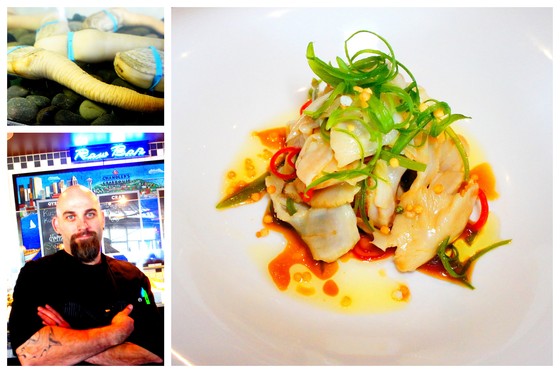It's a big bivalve, a giant clam of the Hiatellidae family that generations of native Americans called "dig deep," and modern scientists call Panopea abrupta. They live virtually forever, these clams do, burrowed in the sandy tidelands off northwestern Washington and southwestern British Columbia, feeding through long, rough-skinned trunks. (And, yes, tee-hee, it looks like a giant schlong.) Remove that skin, though, and you've got something quite delicious.
Thomas Cullen, who put the crudo on the appetizer menu at Chandler's Crabhouse, is hardly the first chef to fall in love with geoduck. Jon Rowley touted it some years back as the next big thing in restaurants. It's long been a standby at seafood houses in the International District (notably Honey Court). Any number of Ethan Stowell restaurants feature it (Goldfinch Tavern is just the latest). Tanglewood Supreme, Altura, Salare, Seastar, Spur, Bitter/Raw, and Dahlia Lounge. Not to mention the source of the animals, the three Taylor Shellfish oyster bars in Capitol Hill, Queen Anne, and Pioneer Square.
At Chandler's, a one-to-two ounce portion of the sashimi is dressed with chilies, scallions, and yuzu soy, but not until it's ordered (sometimes as often as a dozen times a night). If you do it carefully, you could get a dozen plates of crudo per pound of geoduck.
But wait, aren't they an endangered species? Rubbish. Washington's own Department of Ecology estimates there are 100 million adult animals burrowed in the sands around Puget Sound, and their habitat extends far north into British Columbia as well. Plenty to go around.

Leave a comment